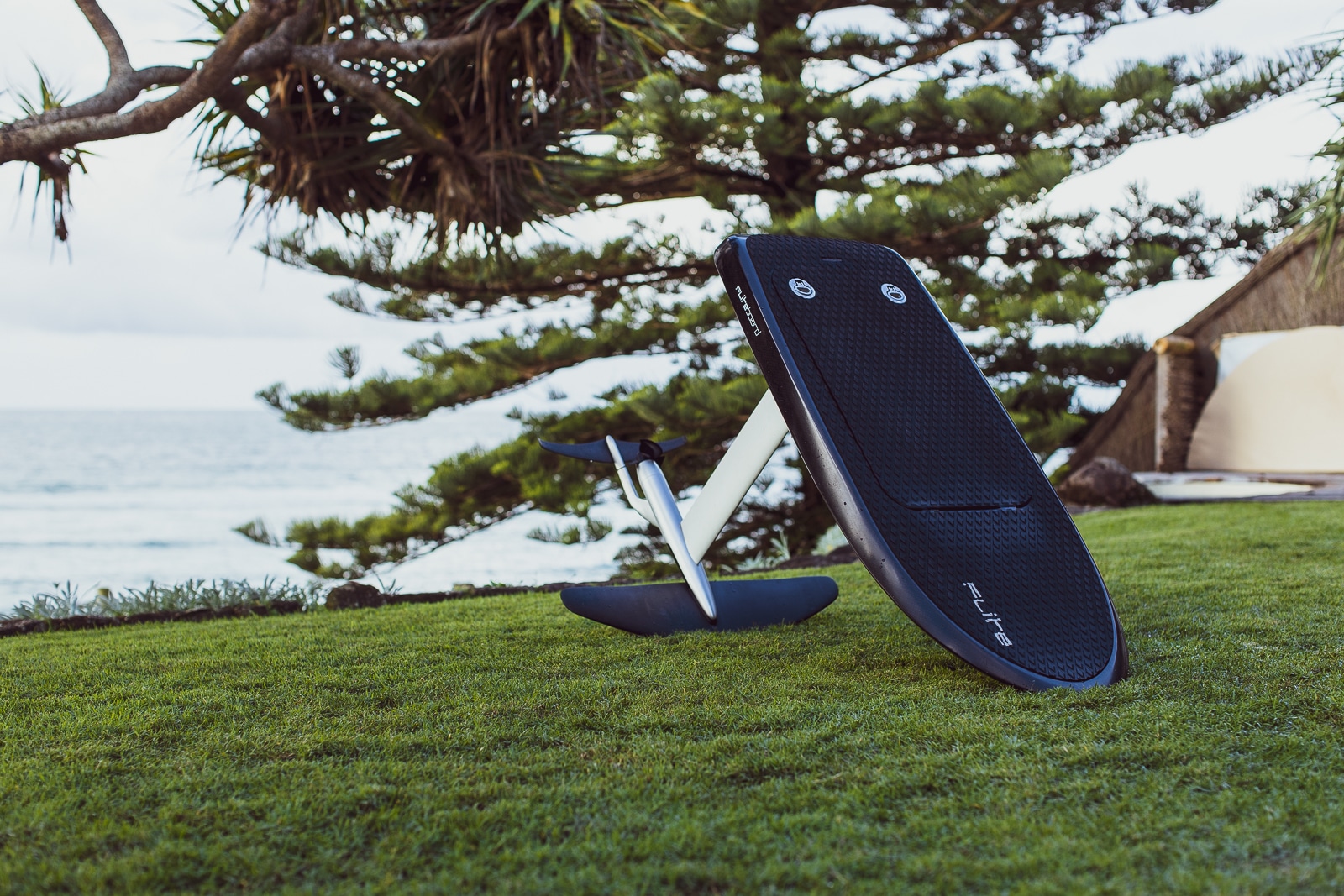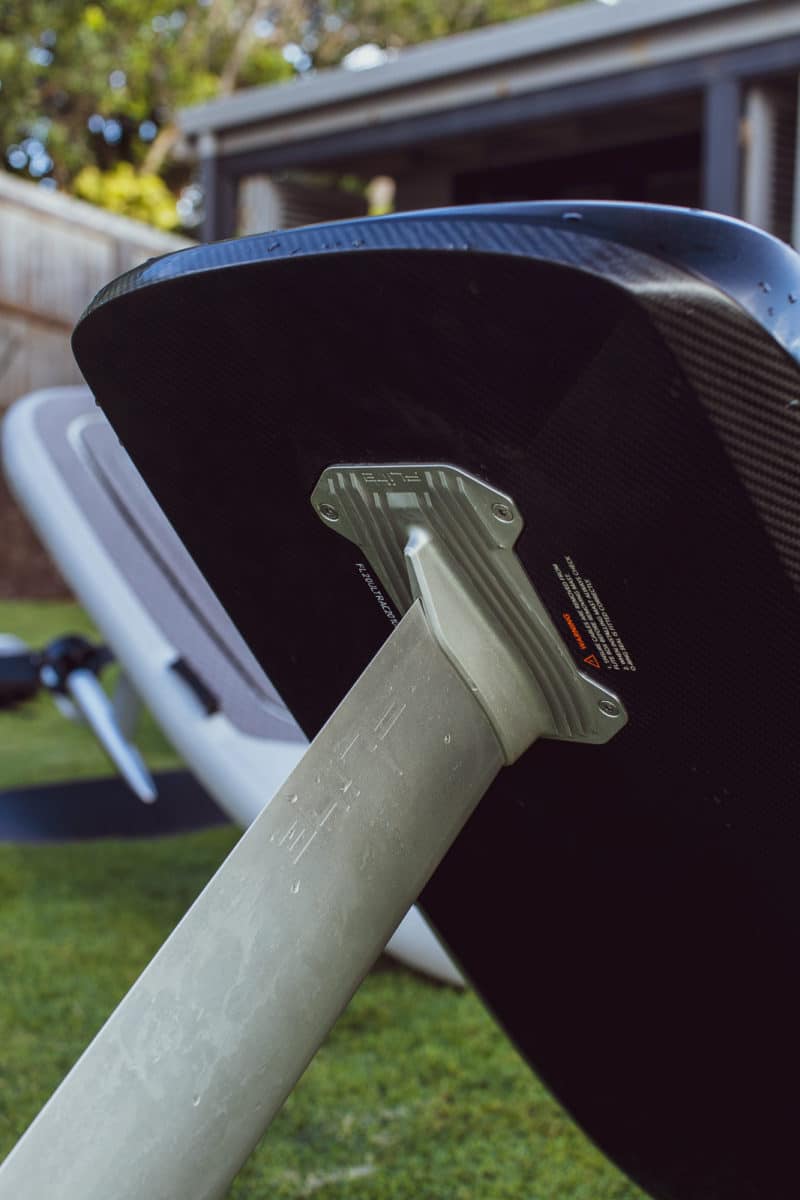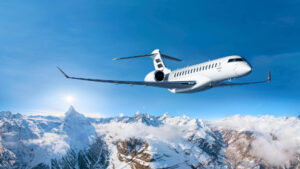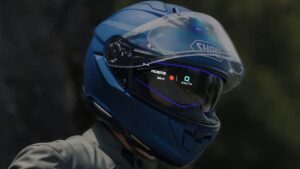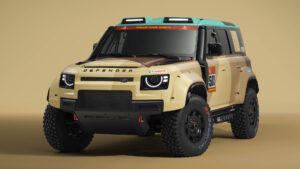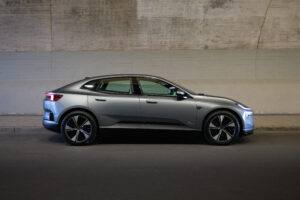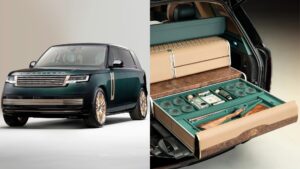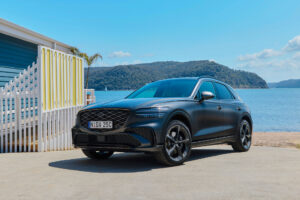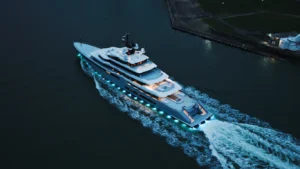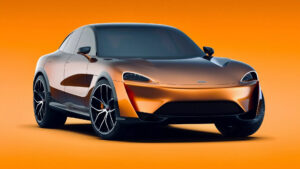Hydrofoil as a concept has existed for over 100 years and has been applied to all manners of watercraft, from Enrico Forlanini’s bizarre ladder-style creation in 1906, to the 1974 Boeing 929 Jetfoil and more recently, the mind-bending America’s Cup AC75, and almost anything imaginable in between. Wider adoption and innovation exploded in the 60s and 70s, spawning not just hydrofoil military and commercial ships but also fantastical personal watercraft for hobbyists. While the list of human-powered-hydrofoil creations borders on straight ridiculous, the foiling water ski – developed by Walter Woodward in the 1960s – transferred the physics to the world of surf, wake, wind, and kite sports, the latter in which Fliteboard Founder David Trewern previously raced.
On one dead flat day, surrounded by like-minded enthusiasts trying to lift their foils, Trewern’s light bulb moment slapped him in the face – why not engineer an electric motor into the mast to generate lift, allowing you to foil in any conditions? Just like that, the Fliteboard electric hydrofoil was born.
After exiting multiple businesses, David Trewern moved to Byron Bay in 2015, determined to take some time off with his family, however, his passion for water sports and entrepreneurial nous shortly got the better of him. His initial concept was to develop a kitefoil-style board with a small motor that could be mounted between the mast and the fuselage, and removed depending on the conditions, before landing on the goal of creating the first commercial electric hydrofoil with the motor integrated into the fuselage.
During 2017, in his loungeroom on Belongil Beach, he funded, toiled and tested over 20 motor prototypes and fuselage combinations, as well as seven battery prototypes (each with roughly 20 iterations) and various Bluetooth hand controllers before landing on the eFoil Fliteboard customers ride today. Today the business employs 45 people with customers in over 100 countries, a new second-generation ‘Fliteboard Series 2’ has just-launched, and they simply can’t make their product fast enough.

So what is foiling and what makes an electric hydrofoil?
A hydrofoil is a wing under the water’s surface used to lift a watercraft until it is above the water, thus creating a more efficient way of cruising. Walter Woodward’s invention relied on momentum and speed from a powerboat, surf foiling from a wave and kitefoiling from the wind, to create lift. Trewern’s Fliteboard electric hydrofoil uses a battery-powered motor, controlled by a Bluetooth hand controller to get the launch the user, get onto the plane, onto their feet and eventually into the air. As the foil cuts through the water, the flow over the wings, and resulting change in velocity, produces the pressure drop needed to create lift, forcing the craft upwards. This allows the rider to sit above the surface and carry momentum without the need for the motor – or in neutral – something Trewern has managed to engineer for more proficient Fliteboard riders.

Fliteboard technology
David Trewern’s Fliteboard is the world’s most awarded electric hydrofoil (eFoil) and with 6 patents and more pending, is paving the way for others to follow by leading from far in front. The entire package can be broken down into four key components – the board, the Flitecell (battery) and Flitebox (the unit that connects to the battery to power the motor), the mast, and the fuselage.
Not to overlook the intricacies of the rest of the machine, but the marine battery has to be one of the most impressive features of the Fliteboard and, of course, it’s emission free. To make the technology possible (and perfect), David and the team trialled 7 different batteries, with 20 prototypes for each, to land on the final iteration used in Fliteboards today. Entirely waterproof (as well as being housed in the Fliteboard’s waterproof compartment), the Flitecell, offered in a Sport or Explore model offers 60+ or 90+ mins of runtime or range, respectively, for the average adult male.
A healthy balance of strength, performance and weight-saving was achieved through interwoven carbon fibre for the board and the fins, combined with expert precision when crafting the aluminium mast and drivetrain to within millimetres of accuracy. A dedicated app collects session data, registering top and average speeds, range, location, hours among other useful information.
The boards
Fliteboard offers four models: Fliteboard, PRO, ULTRA and AIR, all priced at $17,795. The AIR is positioned as the brand’s most buoyant, stable and durable product – ultimately it’s the easiest package to ‘find freedom’ on. The best way to look at the models is via size and volume, with larger models being the easiest to ride and smaller models built for performance.
The model sizes run as follows:
- The inflatable AIR is 6’0” and 150 litres
- The Fliteboard is 5’8” and 100 litres (the majority of buyers)
- The PRO is 5’0” and 67 litres
- The ULTRA is 4’2” and 54 litres

After travelling to Byron Bay and riding the AIR, Fliteboard and PRO as a beginner, I would recommend purchasing the Fliteboard to start, or even the PRO if you see yourself doing it multiple times a week – especially given the longer mast (eFoil propulsion system) comes standard on all models except the Fliteboard AIR. The smaller volume boards are more challenging to get out of the water but you’ll be proficient at it after a couple of sessions. If you opt for a Fliteboard you’ve got the most versatile setup for the majority of user abilities. If you’re buying for yourself and want to improve quickly, go for a PRO, you’ll have less to spend customising your setup, which I’ll dive into more below.

Customisation
At ~$18k, purchasing a Fliteboard is a serious investment and I was keen to understand what happened once your ability exceeded beginner level.
Fliteboards
As outlined above, all boards can be purchased as individual components and can be fitted to any of the masts. The inflatable is perfect for beginners but also for those who want to make a day of it – with enough stability and volume to ride seamlessly and also carry additional weight (like a waterproof pack or a child). The PRO is designed for advanced riders and experts while the ULTRA (fitted with optional footstraps) takes riding a step further, providing even more carving ability and performance riding waves or taking flite. They all cost $4,550 so starting with the right one is key to keeping your costs down (not that anyone buying a Fliteboard probably cares). It’s worth noting the length and weight of each board and how you plan to transport them but I think the majority of users will find the most longevity in purchasing a Fliteboard or PRO, to begin with.
Wings
This is where customisation reaches new heights as you can option a Fliteboard with race wings or a PRO board with wings designed for stabilisation. After learning to stand on the AIR in the first session, fitted with the largest Cruiser 1800 Front wing, I jumped onto a PRO with a Flow 1300 Front Wing – a loose, high-performance wing, designed for off wave gliding. Jumping from one extreme to the other I was able to experience how these subtle tweaks allow the user to experience monumental differences in response, stability and speed – it’s insane how much more challenging it is. Depending on what type of rider you become or want to master next, be it focused on speed, turns or airs, there is a wing setup optimised for you.
Controller
During our Byron Bay trip, David was using a new prototype controller with a trigger which, when released, puts the engine in neutral, allowing an advanced rider to fly with their own momentum or on waves, as he and his team are testing in Byron Bay.
How to ride
Floating above the water, it would appear that efoiling is a difficult skill to master and while it requires a good sense of balance, due to how sensitive it is to weight shift once in the air, it takes less than an hour to get comfortable standing and not too much longer to start linking small carves. The key for beginners is not to rush standing, but to get settled on your knees and graduate to a standing position. Unlike surfing, where you’re required to stand with the momentum of the wave, you’re managing the speed of your Fliteboard via the controller, thus can take your time. At first, the very forward position seems unnatural but it is vital to managing the centre of gravity once you’re in the air by leaning forward on your front foot to counter the speed and consequent rise of the nose and back to generate more lift to fly.

Once you’ve mastered standing, using the gears to manage your pace is the next step, and less is definitely more if you plan on foiling and flying properly. It’s easy to get caught up trying to go fast but it’s actually more fun flying, which requires accurate foot placement and positioning over the front of board. Leaning back and taking flight, then leaning forward and dipping back into the water is par for the course when starting out and I found myself forgetting to decrease the gears on the controller which was propelling me out of the water faster than I could control, causing me to come off. Once I got synchronised dipping back into the water with a decrease in speed I rode for longer periods and progressed with small carving turns.

Fliteboard quotes a max range of 40km, however, I wouldn’t prioritise range as a huge concern for users as most will be enjoying a short session at a beach or in a river not too far from their vehicle and we rode for an hour comfortably.
Where to ride
While we ventured straight out at Belongil Beach in Byron Bay, I would recommend you learn the basics on a river. The less swell and chop you encounter in your opening few hours, the better. Local rivers and bays clear of the open ocean like Sydney’s Pittwater or Melbourne’s Port Phillip Bay near St Kilda are perfect. Entering and exiting the ocean at a surf beach can be tricky with big swell, even if the surface looks calm out the back. Exercise caution and always ride with a buddy in case either of you finds yourself in a sticky situation.
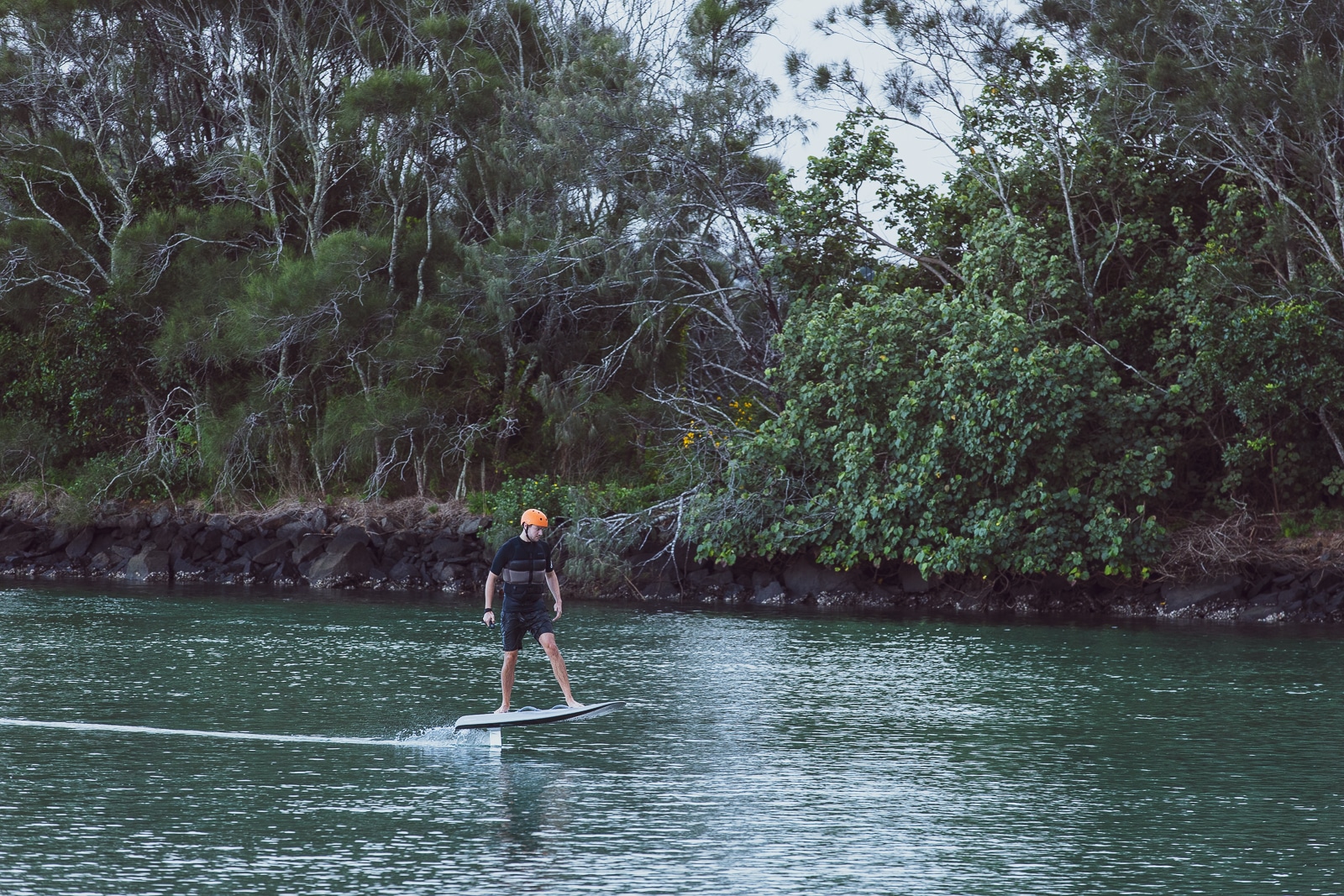
Are Fliteboards legal?
Regulations vary from state to state and country to country. For example in Australia, Fliteboard is exempt from registration in some states, and in others, it must be registered as a vessel. In NSW, Fliteboards are designated as Personal Water Craft and therefore cannot be ridden in Sydney Harbour. That being said, you do not need a licence unless you exceed 10 knots in most other waterways (which is the average foiling speed anyway). This information may change, however, so it’s your responsibility to research the laws yourself and prioritise your and other’s safety.

What’s in the box?
Actually, for your significant investment, you get the privilege of opening a total of three packages when your Fliteboard arrives in the mail. The first is the Fliteboard eFoil propulsion unit. A large foam segmented case that consists of the mast, Flitecell (the little black box that goes inside the board), industrial-grade charger, wings and the Flite controller. Arriving alongside this package is the board itself, packed and shipped as you would expect a normal surfboard to be in a standalone board bag, with extra padding and protection from the brand’s internal ‘bikini’ padding. The final piece of the puzzle is the lithium marine battery – which is incredibly dense and heavy – and requires specialised shipping given it’s classified as ‘dangerous goods’. It’s worth noting that the battery may not arrive as promptly as the other two packages, depending on where in the world you are.

Fliteboard assembly
Various Fliteboard parts, including the carbon board are constructed around the world before being shipped to Australia for quality control and assembly at their Headquarters in Byron Bay. Other components, like the battery and Flitebox, are designed and manufactured in Australia and are installed alongside the mast, motor and the fuselage on site – everything is done by hand. In the open warehouse, perched above the assembly line, are the offices of Founder David Trewern and the wider team, ensuring the entire operation is as cohesive as possible.
Conclusion
There’s no arguing that upon first glance, Fliteboarding appears gimmicky (or even fake to the many trolls who were quick to pin down the phenomenon to CGI), but that’s completely dispelled the moment you’re up and riding. Fliteboard is a marriage of innovation, design, tech and the elements that unlock a foreign fun most have never been able to enjoy until it became electrified. It’s not often as adults we experience something new, but rest assured that when you achieve that magic carpet sensation once, you’ll never be satisfied without it time and time again.
Check out the website and our video below.
